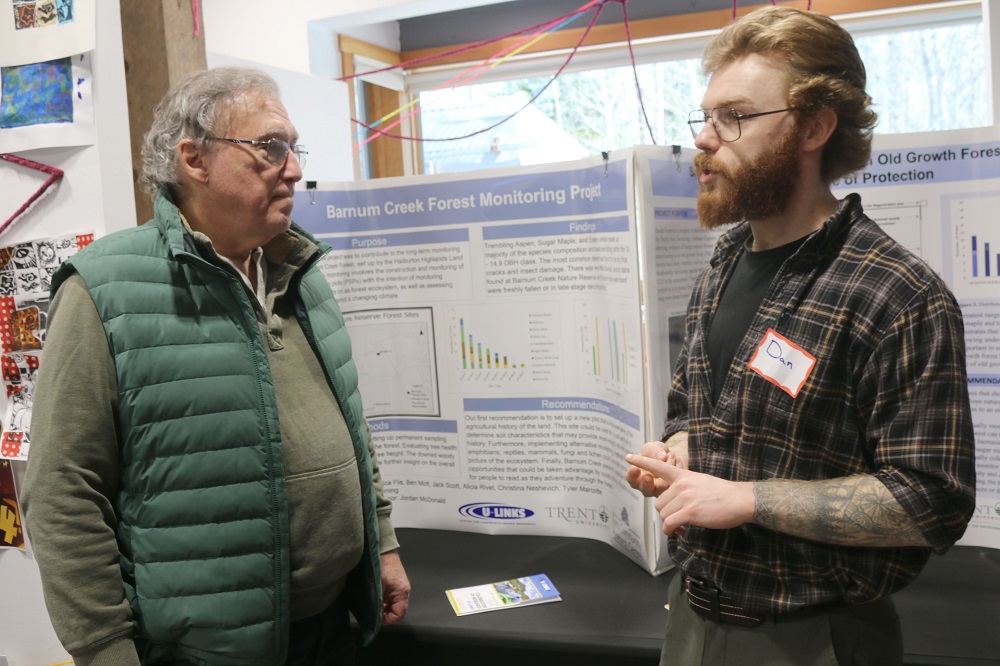It’s been a busy year for staff at U-Links, partnering with post-secondary students on 26 community-based research projects since last summer.
There was a full house at Haliburton School of Art + Design March 23 as the organization presented its findings at its annual celebration of research event. Some of the key takeaways included an economic breakdown on the benefits of owning an apple tree, the discovery of an ancient fault line beneath Grace Lake, and revelation that a wetland abutting the waterbody in Wilberforce could quality for provincially significant status.
Keynote speaker Sean Campbell said his firm, Union Cooperative, helped bring 58 new affordable rentals to Waterloo Region in 2022. The $16.5 million project was funded by contributions from a 200-plus person membership, charitable organizations, and businesses. Tenants are charged belowmarket rents, collectively saving them approximately $700,000 per year.
Campbell said the only way to address the Highlands housing crisis is to tackle it head-on.
“Could there be a change to municipal policies to further encourage development? Is there an opportunity for greater collaboration between local agencies? What land is available that could be opened for development, how to finance potential builds,” Campbell said.
The Ontario government has opened $1.2 billion in funding to incentivize housing developments. The federal government is getting involved too, announcing last month a $175 million investment to build 5,200 new housing units in Edmonton.
Student-led projects
Carmen Galea, of Toronto Metropolitan University, presented ATIP Haliburton, launched last year by Luba Cargill, who wanted a database of apple tree locations in the County. Galea said they discovered 170 apple tree locations, with Dysart et al and Highlands East having the most significant sites, with orchards at Abbey Gardens and Killara Station.
Wesley Ford, of Trent University, focused on the economic benefits. He said the County is producing 81,600 apples annually, with about 40 varieties, including atlas, yellow transparent and York imperial. If someone wanted to create a new orchard, it could be quite lucrative, with a five-acre plot fitting 250 trees, producing 100,000 to 120,000 apples per year. Those apples could return $37,000 annually, while also supplementing local apple sauce and apple juice programs.
The research of Fleming College students Rae Di Vito, Steven Del Ben Belluz and Madison Florence suggest a fault line exists beneath Grace Lake. The students partnered with U-Links after Dave Freeman, who is writing a book about the history of the lake and the Wilberforce community, found a map from the 1990s showing a possible fault line. Di Vito said her geological technician program class conducted seismic, radiometric, electromagnetic and gravity surveys before arriving at their conclusion. Work is continuing.
Trent’s applied bio-monitoring class started what student Dan Vandeloo said is a long-term, five-year project analyzing the biological makeup and health of the Smith Forest, Barnum Creek, Big Hawk Lake, Kabakwa Lake, and Halls Lake.
“The purpose is to set up an archive of how these forests look as they [age]. With the lakes, we’re assessing aquatic invertebrates to get a sense of what species are present and what that means for water quality,” Vandeloo said.
After studying a small section of wetland fronting Grace Lake, Trent students Ainsley Taggett, Emily Colautti, and Jessica Livingstone said the discovery of low bush cranberries and evidence of moose frequenting the area suggest it could qualify for provincially significant status, though a thorough analysis of the entire wetland, largely on private property, would be required.





